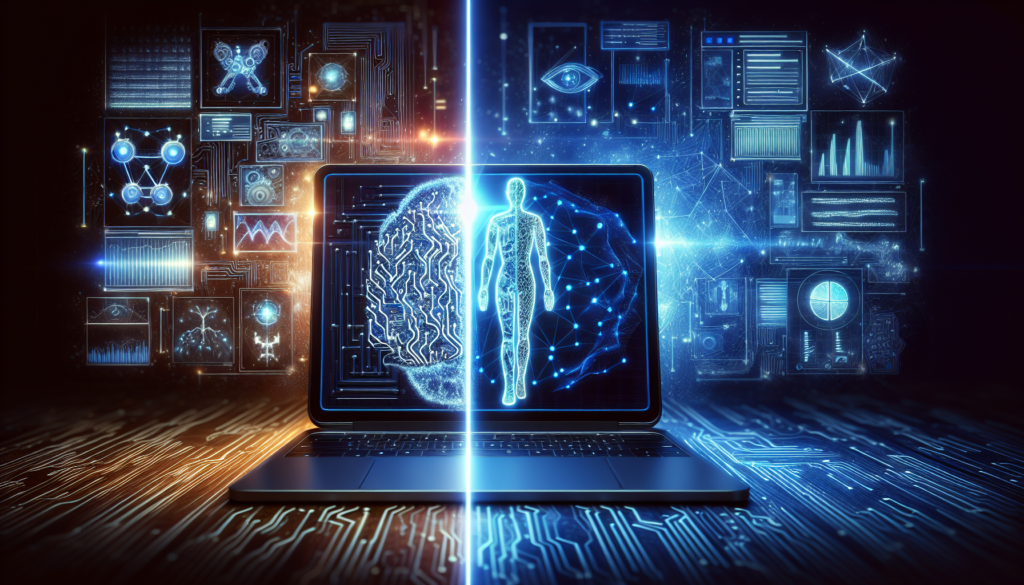If you’ve ever pondered the differences between AI and ML and wondered which one would be more beneficial to learn, you’re not alone. With advancements in technology, the lines between artificial intelligence (AI) and machine learning (ML) have become blurred for many. Both are integral components of the tech world, but understanding which one to focus on can be a daunting task. In this article, we’ll explore the nuances between AI and ML, helping you navigate the decision-making process to determine which one is the better choice for you to learn.

AI vs. ML
Artificial intelligence (AI) and machine learning (ML) are two closely related fields that have seen significant growth and development in recent years. While they are often used interchangeably, it is important to understand the differences and similarities between AI and ML. Both have their unique applications and offer exciting opportunities for those looking to learn and pursue a career in these fields.
Definition and Overview
Artificial Intelligence (AI) refers to the development of computer systems that can perform tasks that would typically require human intelligence. It involves creating intelligent machines that can simulate human behavior, understand human speech, learn from experience, and make decisions autonomously.
On the other hand, Machine Learning (ML) is a subset of AI and focuses on developing algorithms that enable machines to learn and improve from experience without being explicitly programmed. ML algorithms learn from patterns and data, allowing them to make predictions and decisions without human intervention.
Differences and Similarities
The main difference between AI and ML lies in their approach. While AI aims to create intelligent machines capable of mimicking human behavior, ML focuses on developing algorithms that enable machines to learn from data and improve their performance.
However, it is important to note that ML is a crucial component of AI. ML algorithms are often used in AI systems to enable them to learn from data and make intelligent decisions. In other words, AI is the broader concept, while ML is a subset of AI.
Applications in the Real World
Both AI and ML have a wide range of applications in various industries. AI is utilized in autonomous vehicles, virtual assistants, fraud detection systems, and recommendation systems, among others. ML, on the other hand, is used in areas such as predictive analytics, natural language processing, computer vision, and medical diagnosis.
AI and ML are transforming industries and revolutionizing the way businesses operate. As these technologies continue to advance, their applications in the real world are expected to increase, creating a demand for professionals skilled in AI and ML.
Understanding Artificial Intelligence (AI)
Definition of AI
Artificial Intelligence (AI) is a field of computer science that deals with the development of intelligent machines capable of performing tasks that would typically require human intelligence. AI systems are designed to perceive their environment, understand natural language, learn from experience, and make decisions autonomously.
Types of AI
There are different types of AI, ranging from narrow AI to general AI. Narrow AI, also known as weak AI, is designed to perform specific tasks and function within a limited domain. Examples of narrow AI include virtual assistants like Apple’s Siri and Amazon’s Alexa.
General AI, on the other hand, refers to machines that possess human-level intelligence and can perform any intellectual task that a human can do. While general AI is an area of active research, it is yet to be fully realized and remains largely theoretical.
Key Concepts in AI
To understand AI, it is essential to familiarize yourself with key concepts such as machine learning, natural language processing, computer vision, and robotics. Machine learning is a crucial aspect of AI, enabling machines to learn from data and improve their performance without being explicitly programmed.
Natural language processing allows machines to interact with humans in a way that simulates human language understanding and generation. Computer vision focuses on giving machines the ability to see and interpret visual information, while robotics involves creating physical machines capable of performing tasks autonomously.
Understanding Machine Learning (ML)
Definition of ML
Machine Learning (ML) is a subset of AI that focuses on the development of algorithms that enable machines to learn and improve from experience without being explicitly programmed. ML algorithms learn from patterns and data, allowing them to make predictions and decisions without human intervention.
Types of ML
There are different types of ML, including supervised learning, unsupervised learning, and reinforcement learning. In supervised learning, algorithms are trained using labeled data, where the correct answers are provided. This type of ML is commonly used for tasks such as classification and regression.
Unsupervised learning, on the other hand, involves training algorithms with unlabeled data. The algorithms discover patterns and structures in the data on their own, without any predefined labels. This type of ML is often used for tasks like clustering and anomaly detection.
Reinforcement learning is a type of ML where an agent learns to interact with an environment and maximize its rewards. Through trial and error, the agent learns the optimal actions to take in different situations.
Key Concepts in ML
To gain a deeper understanding of ML, it is important to grasp key concepts such as feature extraction, model evaluation, and algorithm selection. Feature extraction involves selecting relevant features from the data that will be used to train the ML algorithm.
Model evaluation is the process of assessing the performance of the ML model by using various metrics such as accuracy, precision, and recall. Algorithm selection involves choosing the appropriate ML algorithm based on the specific task and the characteristics of the data.
Advantages and Disadvantages of Learning AI
Advantages of Learning AI
There are numerous advantages to learning AI. First, AI offers exciting career prospects, with a growing demand for professionals skilled in AI technologies. Industries such as healthcare, finance, and manufacturing are embracing AI, creating plenty of job opportunities.
Second, learning AI allows you to work on cutting-edge technologies and contribute to the development of intelligent systems that can have a meaningful impact on society. AI has the potential to revolutionize various sectors, from transportation and agriculture to education and cybersecurity.
Third, AI is a field that encourages continuous learning and adaptability. The rapid advancements in AI require professionals to stay updated with the latest trends and techniques, making it a dynamic and constantly evolving field.
Disadvantages of Learning AI
While there are many advantages to learning AI, it is important to consider the potential disadvantages as well. First, AI is a complex field that requires a strong foundation in mathematics, statistics, and computer science. Learning AI can be challenging and overwhelming, especially for individuals without a technical background.
Second, the ethical implications of AI are a significant concern. As AI technologies become more advanced, there is a need for responsible and ethical development and deployment. Understanding the ethical implications and addressing potential biases and privacy concerns is crucial when working with AI.
Third, AI can lead to job displacement and workforce changes. As AI systems automate certain tasks, some jobs may become obsolete while new roles and skills become in demand. It requires individuals to adapt and reskill to remain relevant in the job market.

Advantages and Disadvantages of Learning ML
Advantages of Learning ML
Learning ML offers several advantages. First, ML is a valuable skill in today’s data-driven world. It enables professionals to extract insights from large datasets and make data-driven decisions. ML is widely used in fields such as finance, marketing, healthcare, and cybersecurity.
Second, ML allows for automation and efficiency improvements. ML algorithms can automate repetitive tasks, saving time and resources. This helps businesses streamline processes and focus on more strategic activities.
Third, ML provides opportunities for innovation. By leveraging ML techniques, individuals can develop new products and services, improve existing systems, and discover patterns and insights that were previously undiscovered.
Disadvantages of Learning ML
While learning ML can be advantageous, there are also some disadvantages to consider. First, ML requires a solid understanding of mathematics, statistics, and programming. Individuals without a technical background may find it challenging to grasp the concepts and algorithms used in ML.
Second, ML relies heavily on data availability and quality. The success of ML models depends on the availability of large and diverse datasets. However, obtaining and preparing such datasets can be time-consuming and costly.
Third, ML models can suffer from biases and inaccuracies. The performance of ML models heavily depends on the quality and representativeness of the data used for training. If the data contains biases or is not representative of the real-world scenarios, the ML models may produce biased or inaccurate results.
Choosing Between AI and ML
Career Prospects
When considering whether to learn AI or ML, it is important to evaluate the career prospects in each field. Both AI and ML offer promising career opportunities, but the specific roles and job titles may vary.
In the AI field, career paths may include roles such as AI researcher, data scientist, machine learning engineer, AI consultant, or AI product manager. These roles involve developing and implementing AI systems, conducting research, and solving complex problems using AI technologies.
In the ML field, career paths may include roles such as data analyst, data scientist, machine learning engineer, predictive modeler, or ML consultant. These roles focus on utilizing ML algorithms, analyzing data, and creating models that make accurate predictions or classifications.
Skills and Knowledge Required
Consideration should also be given to the skills and knowledge required in each field. AI, being the broader concept, requires a strong foundation in machine learning, natural language processing, computer vision, robotics, and other key AI concepts.
ML, on the other hand, requires a deep understanding of ML algorithms, data analysis, feature extraction, model evaluation, and algorithm selection. It also requires proficiency in programming languages such as Python or R and familiarity with libraries and frameworks commonly used in ML, such as TensorFlow or scikit-learn.
Personal Interests and Goals
Ultimately, the choice between AI and ML should also take into account personal interests and goals. Consider the specific areas within AI or ML that align with your passions and career aspirations. Assess whether you enjoy working with large datasets, developing complex algorithms, conducting research, or implementing solutions in real-world applications.
It is also important to consider whether you prefer a broader understanding of AI or a more focused expertise in ML. Both fields offer exciting opportunities and require continuous learning and staying up-to-date with the latest advancements.
Learning Resources for AI
Online Courses
There are numerous online courses available for learning AI. Platforms like Coursera, edX, and Udacity offer courses taught by leading experts in the field. Some popular AI courses include “AI For Everyone”, “Deep Learning Specialization”, and “Artificial Intelligence Nanodegree”.
Books and Publications
Books are a valuable resource for learning AI concepts and theories. Some recommended books for beginners include “Artificial Intelligence: A Modern Approach” by Stuart Russell and Peter Norvig, “Deep Learning” by Ian Goodfellow et al., and “Machine Learning Yearning” by Andrew Ng. Additionally, keeping up with publications like “IEEE Transactions on Pattern Analysis and Machine Intelligence” can provide insights into the latest research and developments in AI.
Certifications
Obtaining certifications can demonstrate your skills and commitment to learning AI. Organizations such as Microsoft, IBM, and Google offer AI certifications that cover various topics, including machine learning, natural language processing, and computer vision. Some popular certifications include Microsoft Certified: Azure AI Engineer Associate, IBM Watson AI Foundations, and Google Cloud Certified – Professional Data Engineer.
Learning Resources for ML
Online Courses
For those interested in learning ML, several online courses can provide a comprehensive understanding of the subject. Platforms like Coursera, Udacity, and Kaggle offer ML courses suitable for beginners and advanced learners. Popular ML courses include “Machine Learning” by Andrew Ng, “Applied Data Science with Python” by University of Michigan, and “Deep Learning Specialization” by deeplearning.ai.
Books and Publications
Books are valuable resources for learning ML concepts and techniques. Some recommended books for beginners include “Hands-On Machine Learning with Scikit-Learn, Keras, and TensorFlow” by Aurélien Géron, “Pattern Recognition and Machine Learning” by Christopher Bishop, and “The Hundred-Page Machine Learning Book” by Andriy Burkov. Keeping up with publications like the “Journal of Machine Learning Research” can also provide insights into the latest research and advancements in ML.
Certifications
Certifications in ML can validate your expertise and enhance your credibility. Organizations like Google, Microsoft, and Amazon offer ML certifications that cover topics such as data analysis, ML algorithms, and model deployment. Some notable certifications include Google Cloud Certified – Professional Data Engineer, Microsoft Certified: Azure Data Scientist Associate, and AWS Certified Machine Learning – Specialty.
Future Trends in AI and ML
Emerging Technologies
The fields of AI and ML are continuously evolving, and several emerging technologies are expected to shape their future. Some of these technologies include deep learning, natural language processing, computer vision, reinforcement learning, and robotics.
Deep learning involves training artificial neural networks with multiple layers to learn complex patterns and representations. Natural language processing focuses on enabling machines to understand and generate human language. Computer vision aims to give machines the ability to analyze and interpret visual information. Reinforcement learning involves training agents to learn from interactions with an environment and maximize rewards. Robotics combines AI and robotics to create intelligent machines capable of physical tasks.
Industry Applications
AI and ML are finding applications across various industries. In healthcare, AI is used for disease diagnosis, personalized treatment recommendations, and drug discovery. In finance, ML is utilized for fraud detection, risk assessment, and algorithmic trading. In transportation, AI is employed in autonomous vehicles and traffic management systems. In education, AI is used for personalized learning and intelligent tutoring systems. These industry applications demonstrate the vast potential and impact of AI and ML in our daily lives.
Conclusion
Considering whether to learn AI or ML requires an understanding of the definitions, differences, and similarities between the two fields. AI aims to develop intelligent machines that simulate human behavior, while ML focuses on developing algorithms that enable machines to learn and improve from experience. Both fields offer exciting career prospects but require specific skills and knowledge. Personal interests and goals should also be taken into account when choosing between AI and ML.
To learn AI, online courses, books, and certifications are valuable resources. Platforms like Coursera and edX offer courses taught by experts, and books like “Artificial Intelligence: A Modern Approach” provide comprehensive coverage of AI concepts. Certifications from organizations like Microsoft and IBM can enhance your credentials.
For those interested in learning ML, online courses, books, and certifications are also available. Platforms like Udacity and Kaggle offer ML courses suitable for beginners, and books like “Hands-On Machine Learning with Scikit-Learn, Keras, and TensorFlow” provide practical guidance. Certifications from Google and Amazon can validate your ML expertise.
The future of AI and ML looks promising, with emerging technologies like deep learning and natural language processing driving advancements. The applications of AI and ML extend across various industries, showcasing their transformative potential. Continuous learning and adaptability are crucial in these fields, as they constantly evolve and present new challenges and opportunities. Whether you choose to learn AI or ML, embracing continuous learning will ensure you remain at the forefront of these exciting fields.
